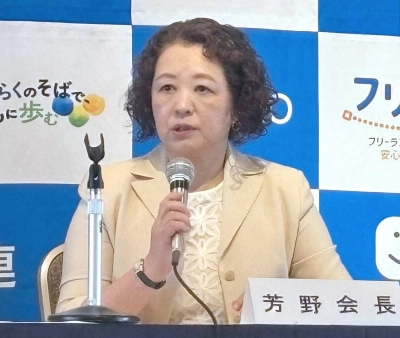Ever evening at sunset, Maruyama Keizo, 64, and his brother Motoichi, 54, of Minabe, Wakayama Prefecture, take their boat out and return the next morning at dawn with their catch: either flatfish or sardines, depending on the season. In his 50-year working life, Maruyama has seen shrinking catches, the growth of aquaculture and an exodus of young people into the cities.
But for coastal fisheries like his, many things are still the same. In this village, where his cooperative has no quotas limiting catch size and restaurants serve mountains of seafood, predictions of a global fish crisis seem exaggerated. But according to the Food and Agriculture Organization, the reality is that 70 percent of the world's fisheries are now in serious trouble, and the rich and ancient marine ecosystem, home to 80 percent of all life on earth, is going through changes on a scale never seen before.
The forces behind this include climate change, pollution, population growth, high-tech and industrialized fishing methods, the use of dynamite or cyanide in coral reefs, the globalized, growing market for seafood and by-catch -- the accidental netting of unwanted marine life.
Worse, while fish numbers drop, fishers are working harder to find them. They are hunting further down the food chain and catching younger, smaller fish. This slows the rate at which the fish reproduce and removes prey for the remaining predators.
Fisheries are investing in sophisticated navigational systems and trawling the ocean floors, taking up everything on them, wanted or not. The marine advocacy organization Oceana estimates that shrimp trawling alone collects 2.3 kg by-catch (including endangered species such as sea turtles) for every kilogram of shrimp, all of which goes to waste. Greenpeace has been strongly critical of mammoth, state-of-the-art "factory trawlers" that can catch and process a whopping 2 million kg in a single day.
The collapse of fisheries and steady declines in the global catch have come as wake-up calls to fishing nations, pushing them toward increasingly tougher international agreements. But in an age where severely overfished bluefin tuna are flown overnight to Tokyo auctions and fetch up to 2 million yen apiece, the problem lies in enforcing these agreements. Fish is now a global commodity, flown mainly from the developing world (where fisheries are often unregulated or badly managed) to feed the growing appetite for seafood in affluent nations. This borderless system erases accountability, invites violation of international laws and often prevents merchants and consumers from knowing the origin of the fish they buy or sell.
Though Japan has cut fleets, keeps strict records and monitors stocks, it is the world's largest consumer, eating up roughly one-third of the world's catch. As the leading market for fresh tuna, which is 10 to 30 times more expensive than canned tuna, it has fueled the rapid growth of bluefin tuna fishing. As well as its unpopular stance on whaling, Japan, along with South Korea, China and the European Union, have not yet signed a 2001 agreement on migratory fish stocks. Both Japan and South Korea also oppose a regional agreement on tuna conservation in the Pacific region.
According to the World Watch Institute, the implications of a global fish crisis could be profound. The expected plunge in stocks may spur violent conflicts between fishing nations, affect global food security for millions of people and obliterate traditional fishing cultures worldwide. Meanwhile, upscale markets will attract more and more of the shrinking fish supply, driving up prices and putting seafood out of reach in the developing world where the protein is most needed.
Organizations such as the FAO are looking to the aquaculture industry for solutions. Moritaka Hayashi, former assistant director of the FAO's Fisheries Department, says: "[It] has a huge potential. But there are problems, especially environmental."
Along coasts and mangrove swamps all over Southeast Asia, for example, waste water from shrimp farms contaminates ponds until they must eventually be abandoned, while the businesses continue the destruction elsewhere. But Hayashi is cautiously optimistic: "There are success stories in Japan, and they should be transferred more to [developing countries]."
Shiraishi Yuko, of the Women's Forum for Fish, agrees: "I think it will solve the problem partially, but we have to keep in mind that aquaculture uses a lot of feed from wild fish."
The good news is that experts say there is still time to turn some things around -- with a lot of cooperation and effort. "Marine reserves" are being proposed as sanctuaries off-limits to fishing to allow populations to recover.
With the understanding that market demand can protect -- or destroy -- a species, consumer movements have sprung up. It was these buying choices that led to the "dolphin-free" labeling on canned tuna. Many fisheries have moved away from the shortsighted approach that led to earlier booms and busts, and are introducing fish quotas, limits on boats and equipment, and taking other measures agreed on by fishers, scientists and managers.
In the United States, this has led to remarkable rebounds of wild salmon in Alaska. Whether these schemes can be made to work everywhere, especially in developing countries, is an unknown. But one crucial part of the Alaskan fishery's success can be modeled anywhere: The spawning rivers are undammed and the surrounding forests are left intact; a powerful illustration that healthy environments equal healthy stocks. This more holistic approach may be a result of lessons from the past, but for indigenous fishing communities, and small-scale fishers like Maruyama and his brother, it's simply common sense.
"When I was a child," he says, "my father talked about the connection of the fish to the trees, plants and animals on the shore. The whole ecosystem was important, not just the sea. I didn't know what he meant back then, but I understand now."
In Japan, with seafood on the table at almost every meal, little consumer awareness and no system of eco-labeling, it's hard to know from where -- or how -- the seafood comes to your plate.
This list of recommendations, including Japanese translations, are based on a fish's status and the methods of catching or raising it.
Avoid: bluefin tuna (kuromaguro or honmaguro, found in sashimi; "FOC" tuna has the most questionable origin and is called kaizoku gyosen no totta maguro); shrimp (ebi); shark (same); swordfish (mekajiki); Patagonian toothfish (mero); monkfish (anko); and grouper (hata).
Alternatives: sea bass (suzuki); tilapia (izumidai); sablefish (tachiuo); salmon (sake, from Alaska, or Japan, wild, not farmed); herring (nishin); Pacific halibut (no Japanese name); mahimahi (no Japanese name)
Check www.seafoodchoices.com for a more detailed list and other links.

















With your current subscription plan you can comment on stories. However, before writing your first comment, please create a display name in the Profile section of your subscriber account page.